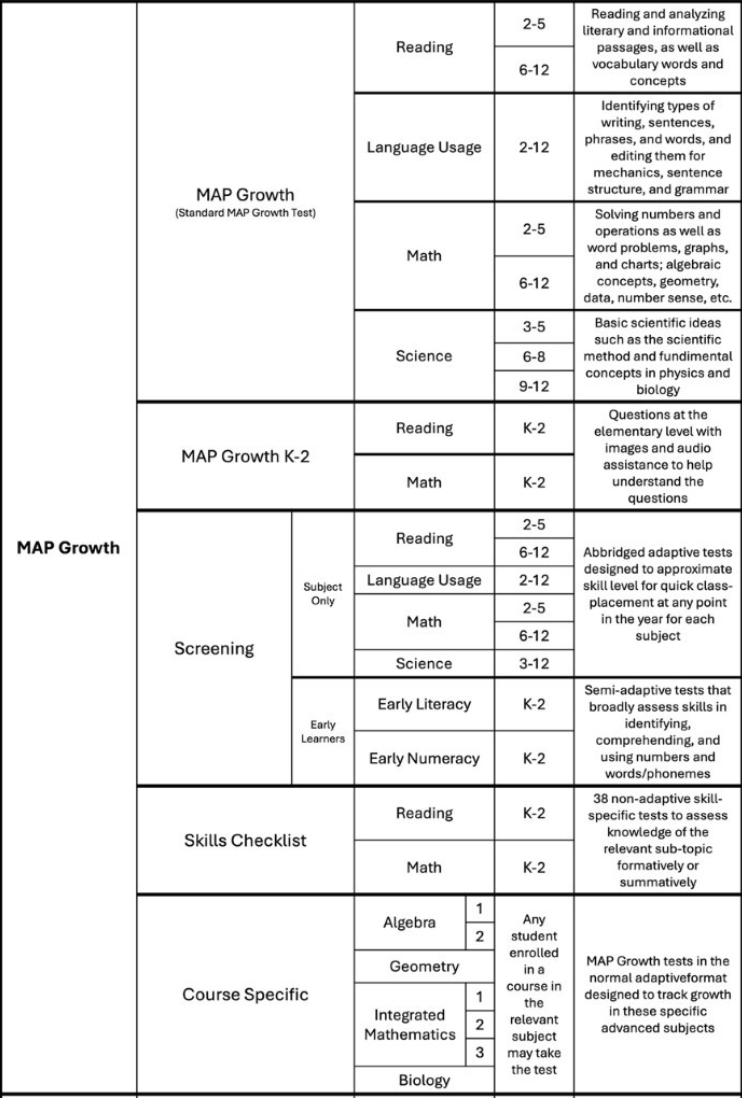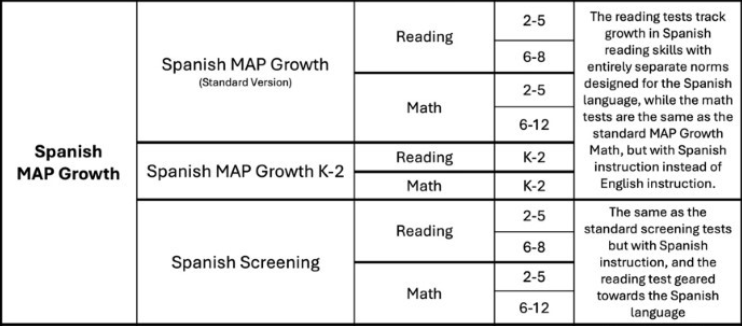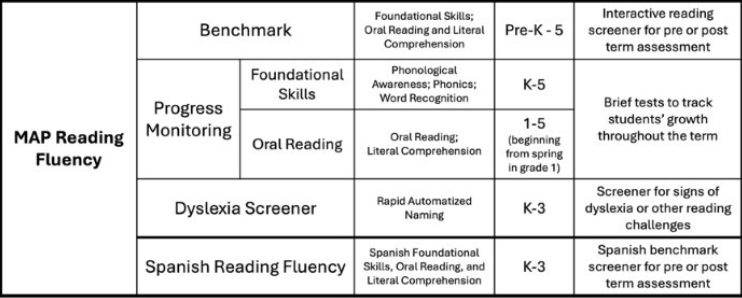Learn about the NWEA and everything it offers. Known for its MAP assessments, the NWEA provides encompassing educational resources that help enhance and track the education of millions of students around the world.
What is the NWEA?
The NWEA (Northwest Evaluation Association) is an organization that strives to enhance education in schools by providing assessments and corresponding comprehensive evaluations, as well as tailored resources to help the individual student or educator optimize their education in the classroom.
The NWEA uses assessments called MAP (Measures of Academic Progress) that adapt to the individual student to provide the most accurate picture of their progress in each subtopic. Their performance is measured along a progression of Common Core standards called Descartes Statements and quantified with a metric called RIT (Rasch Unit) that indicates the level of progress.
Students, parents, teachers, and administrators can view detailed reports of their MAP results on the individual and collective level and use this information to determine what is needed most, what needs to improve in the classroom, and which type of materials are needed to foster the greatest growth in the school. The NWEA then provides a number of options for educational resources, lesson plans, and guided education that is automatically catered to the MAP results.
These are usually designed by independent organizations that work with the NWEA to tailor the material to the students’ scores, but the NWEA also has an organic program that they developed to help students and teachers in their educational process for mathematics, as you can see below. [link to accelerator]
NWEA MAP Test Breakdown
Here we will present all the different types of MAP assessments and highlight the purpose and characteristics of each one.
MAP Growth
The MAP Growth is the main series of standardized tests offered by the NWEA, designed to track the progress of students, classes, and schools in reading, language usage, math, and science. These computer-adaptive tests use a specialized metric of academic growth called RIT to pinpoint a student’s level of progress along a universal series of standards and benchmarks, allowing each student to advance or regress even to questions outside their grade-level.
The math and reading tests are each divided into two separate banks of questions, one version geared toward the 2nd-5th grade levels and the other intended for 6th grade and higher. The science test has three separate versions: for grades 3-5, grades 6-8, and grades 9-12 (high school level). The language usage test gives the same version to all eligible grades.
Each student begins at their own average grade level, and the questions rise or fall in academic level based on the student’s answers; the final score reflects the level of question a student is determined to have an even chance of answering correctly.
For more on the MAP Growth, its different tests, levels, and unique method of scoring, view the following page complete with detailed descriptions and sample questions:
MAP Practice Test & Info
MAP K-2
Along with the standard MAP Growth tests described above, there are a number of specialized tests under the MAP Growth moniker. While the standard tests are given to students in age groups as listed above, the younger students are actually given an entirely separate test that offers more image-based questions and audio instruction for the questions.
This is called the MAP Growth K-2, part of the early learning suite (or early learners) of the MAP, and it is administered in kindergarten and 1st grade, with an option to take it in 2nd grade as well. While students may score above the 2nd grade level, any material they see will be in the k-2 child-friendly format.
For more information and sample questions for the MAP K-2, check out the following pages:
MAP Kindergarten Free Sample
MAP 1st Grade Free Sample
MAP 2nd Grade Free Sample
MAP Screening Tests and Skills Checklist
In addition to the full-length tests, the MAP Growth offers screening tests for a quicker assessment and more general class placement. Referred to as Screening Subject Only tests, these are also adaptive and have a test corresponding to each of the four subjects—reading, language usage, mathematics, and science—yet they are shorter and provide a broader, less precise picture of a student’s academic level.
For the K-2, or early learning level, the screening tests are divided into Early Literacy and Early Numeracy. The Early Numeracy assesses number recognition, counting, and basic computation, and the Early Literacy assesses phoneme/word recognition from both sound as well as letter representation and letter combinations. Additionally, for more specific assessments at the early learning level, the MAP Growth offers the Skills Checklist tests which focus on 38 different subtopics within reading and math.
Most of the tests are around 20-35 questions long, and they are designed to provide insight into students’ proficiency in several specialized areas of early numerical and literary development.
Both the Screening tests for early learners and the Skills Checklist are scored according to the percentage of questions answered correctly, as opposed to the standard RIT growth monitoring method.
MAP Course Specific Tests
Finally, the MAP Growth includes four course-specific tests at the advanced level, designed to track progress in specific math and science subjects. These include:
- Algebra 1
- Algebra 2
- Geometry
- Integrated Mathematics (levels 1-3)
- Biology
While the standard MAP Growth Math for grades 6+ includes geometric and algebraic concepts at a more basic level, these fields and others are explored in greater depth in the course-specific tests. Each of these assessments is administered in the standard computer-adaptive format at three intervals throughout the school year like the rest of the MAP Growth tests, yet the standards and respective levels are not grade-specific as anyone taking a course in the relevant subject is assessed independent of their age-group.
MAP Test Breakdown - MAP Growth

Spanish MAP Growth
In parallel to the tests of the MAP Growth series, the NWEA offers alternatives for Spanish speaking students, covering many of the most popular tests. Both the Reading and Math tests are offered in Spanish at the K-2, 2-5, and 6+ levels, though the Spanish Reading test is only offered through 8th grade. There is no Spanish version for the Science or Language Usage test, nor for any of the course-specific tests.
The Spanish math assessments are the same as the standard versions, only with Spanish instruction instead of English.
The reading assessments, on the other hand, are specially designed to track growth in Spanish reading comprehension and text analysis with an independent set of norms and standards. The Screening Subject Only tests are also offered in Spanish for math and reading, but the early learning versions are not available in Spanish—neither the Early Literacy and Numeracy tests nor the Skills Checklist.
MAP Test Breakdown - Spanish MAP Growth

MAP Reading Fluency
Introduced towards the beginning of 2018, MAP Reading Fluency pioneered a new and improved method of screening young students for reading ability and difficulties. While teachers could take weeks trying to administer the proper assessments to accurately gage where each of their students stood in their journey learning how to read, the NWEA developed a quick, computer-adaptive, and interactive program that assesses all the students at once.
A friendly animated worm guides the students through a series of engaging activities, speaking to them and reacting to their answers. The assessments are designed as fun, game-like tasks instead of dry test questions, and the students are even asked to read into the microphone as the program is able to analyze their speech for speed, accuracy, and other relevant factors.
Originally designed for kindergarten through third grade, many aspects of the program are now offered for pre-k through 5th grade.
MAP Reading Fluency is divided into three types of tests:
- Benchmark
- Progress Monitoring
- Dyslexia Screener
The Benchmark test is the first step, and it serves as a universal screener for foundational reading skills, literal comprehension, and oral reading fluency. The students can repeat the test at fixed before or after a term up to three times a year.
This is the most crucial reading fluency test, and it is the only one currently offered for Spanish reading as well. There are then shorter Progress Monitoring programs that the teachers can administer whenever they see fit and as many times as they wish throughout the year.
The program continues to adapt to the students’ answers and track their progress, allowing teachers to provide each student with his or her own individual needs. The score reports include suggestions for each student to help them improve in their most crucial deficiencies, tailored to their performances in every subtopic.
There is also a separate Dyslexia Screener for students in kindergarten through third grade designed to identify signs of dyslexia and other potential obstacles in developing reading fluency.The Benchmark test takes approximately 20 minutes to complete.
The teachers can choose how specific they wish the test to be in its assessment of reading skills, as they have four options of focus for the program: only testing early foundational skills such as phonics, phonological awareness, and basic word recognition (for pre-K and Kindergarten), testing foundational reading skills in general (pre-k through 1st grade), only testing oral reading fluency and literal comprehension (middle of grade 1 through grade 5), or having the test prescreen the students and automatically determine which areas and levels each student is ready to be tested in.
The shorter Progress Monitoring tests focus on either foundational skills in reading and phonics or oral reading fluency and comprehension, and each test takes about 5-10 minutes.
MAP Test Breakdown - MAP Reading Fluency




